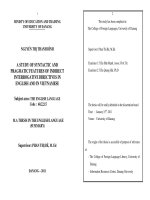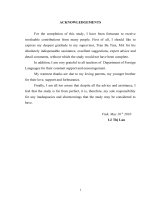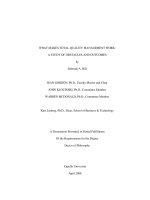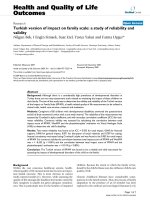A study of modelling and monitoring time between events with control charts
Bạn đang xem bản rút gọn của tài liệu. Xem và tải ngay bản đầy đủ của tài liệu tại đây (1.64 MB, 243 trang )
A STUDY OF MODELLING AND MONITORING TIME-
BETWEEN-EVENTS WITH CONTROL CHARTS
LIU JIYING
NATIONAL UNIVERSITY OF SINGAPORE
2006
A STUDY OF MODELLING AND MONITORING TIME-
BETWEEN-EVENTS WITH CONTROL CHARTS
LIU JIYING
(M.Eng, Northwestern Polytechnic University, China)
A THESIS SUBMITTED
FOR THE DEGREE OF DOCTOR OF PHILOSOPHY
DEPARTMENT OF INDUSTRIAL & SYSTEMS ENGINEERING
NATIONAL UNIVERSITY OF SINGAPORE
2006
ACKNOWLEDGEMENTS
i
ACKNOWLEDGEMENTS
Over the past four years I have had the privilege to work with a number of people who
have generously offered their help, encouragement and support to me, without which
this thesis would not be possible.
First and foremost, I owe a particular gratitude to my “coaches”, Professor Goh Thong
Ngee and Professor Xie Min, for their invaluable guidance and warmly concern
throughout the whole period. Their penetrating ideas, clear thought, and great
enthusiasm in research made working with them an exceptional experience for me, and
I believe such experience will definitely benefit me for the whole life.
Besides, I would like to thank the National University of Singapore for offering me the
Research Scholarship as well as President’s Graduate Fellowship. I am indebted to the
faculty members of Department of Industrial and Systems Engineering, from whom I
have learnt not only knowledge but also skills in research as well as teaching. I am
very grateful to my colleagues in ISE Department for their kindly help, and the co-
authors of the papers for their cooperation. Especially, I would like to thank Lai Chun
and my friends Aldy, Caiwen, Chaolan, Hendry, Henry, Jiang Hong, Josephine, Lifang,
Liu Qihao, Long Quan, Pan Jie, Philippe, Priya, Qingpei, Tang Yong, Tingting, Xin
Yan, Yanping, Yongbin, Zhang Jun, Zhecheng, among others who have helped me in
one way or the other and made my life in NUS enjoyable and fruitful.
ACKNOWLEDGEMENTS
ii
Special appreciation goes to the staffs in Advanced Micro Devices (Singapore) Pte.
Ltd. for their support and collaboration in the project of Time-between-events (TBE)
charts implementation, which enriches this research from practical point of view.
Last, but not the least, my wholehearted thankfulness goes to my parents and brother
for their endless love, support and encouragement. I feel deeply indebted to my
husband Xiaoxun who always provides the best he could to help me continue and
concentrate on my study. This thesis contains much of their effort not in terms of
paragraphs, tables or figures, rather, their understanding and support all the way.
Liu Jiying
December 2006
TABLE OF CONTENTS
iii
TABLE OF CONTENTS
ACKNOWLEDGEMENTS I
TABLE OF CONTENTS III
SUMMARY VIII
LIST OF TABLES X
LIST OF FIGURES XII
NOMENCLATURE XV
CHAPTER 1 INTRODUCTION 1
1.1 STATISTICAL PROCESS CONTROL (SPC) 2
1.2 CONTROL CHARTS FOR HIGH-QUALITY PROCESSES 8
1.3 TIME BETWEEN EVENTS (TBE) CHARTS 12
1.4 OBJECTIVE OF THE STUDY 13
1.5 ORGANIZATION OF THE THESIS 15
CHAPTER 2 LITERATURE REVIEW 17
2.1 CONTROL CHARTS FOR MONITORING TIME BETWEEN EVENTS 17
2.1.1 TBE Charts with Probability Limits 17
2.1.2 TBE CUSUM Chart 20
2.1.3 TBE EWMA Chart 23
2.1.4 Shewhart Control Charts for TBE Monitoring 25
2.2 SOME ADVANCED DESIGN SCHEMES FOR TBE CHARTS 26
2.2.1 Extensions of the CCC & CQC Chart 26
TABLE OF CONTENTS
iv
2.2.2 ARL-unbiased Design 28
2.2.3 Conditional Decision Procedures 30
2.2.4 Estimation Error, Inspection Error and Correlation 33
2.2.5 Monitoring TBE Data Following Weibull Distribution 35
2.2.6 Artificial Neural Network-based Procedure 39
2.2.7 Economic Design of TBE Charts 39
2.3 SUMMARY 41
CHAPTER 3 A COMPARATIVE STUDY OF EXPONENTIAL TIME
BETWEEN EVENTS CHARTS 44
3.1 INTRODUCTION 44
3.2 ATS PROPERTIES OF TBE CHARTS 46
3.3 COMPARISONS OF PERFORMANCE 48
3.3.1 Upper-sided TBE Charts 48
3.3.2 Lower-sided TBE Charts 53
3.3.3 Two-sided TBE Charts 55
3.4 RESULTS & DISCUSSIONS 57
3.5 ON-LINE PROCESS MONITORING BASED ON TBE CHARTS 59
3.6 CONCLUSIONS 65
CHAPTER 4 CUSUM CHARTS WITH TRANSFORMED EXPONENTIAL
DATA 66
4.1 INTRODUCTION 66
4.2 SOME TRANSFORMATION METHODS 67
4.3 CUSUM CHART WITH TRANSFORMED EXPONENTIAL DATA 69
4.4 CALCULATION OF ARL WITH MARKOV CHAIN APPROACH 71
TABLE OF CONTENTS
v
4.5 DESIGN OF CUSUM CHART WITH TRANSFORMED EXPONENTIAL DATA 73
4.6 COMPARATIVE STUDY 78
4.6.1 CUSUM Chart with Transformed Exponential Data vs. X-MR Chart 78
4.6.2 CUSUM Chart with Transformed Exponential Data vs. CQC Chart 80
4.6.3 CUSUM Chart with Transformed Exponential Data vs. Exponential
CUSUM Chart 82
4.7 CONCLUSIONS 86
CHAPTER 5 EWMA CHARTS WITH TRANSFORMED EXPONENTIAL
DATA 88
5.1 INTRODUCTION 88
5.2 THE TRANSFORMED EWMA CHART 89
5.2.1 Setting-up Procedures 89
5.2.2 Calculation of Average Run Length (ARL) 90
5.3 DESIGN OF EWMA CHART WITH TRANSFORMED EXPONENTIAL DATA 95
5.3.1 In-control ARL 95
5.3.2 Out-of-control ARL 98
5.3.3 Optimal Design Procedures 101
5.4 A COMPARATIVE STUDY ON CHART PERFORMANCE 102
5.4.1 EWMA chart with transformed exponential data vs. X-MR chart 102
5.4.2 EWMA chart with transformed exponential data vs. CQC chart 104
5.4.3 EWMA chart with transformed exponential data vs. Exponential EWMA 106
5.5 ROBUSTNESS OF EWMA CHART WITH TRANSFORMED EXPONENTIAL DATA TO
WEIBULL DATA 109
5.6 AN ILLUSTRATIVE EXAMPLE 114
5.7 CONCLUSIONS 116
TABLE OF CONTENTS
vi
CHAPTER 6 CCC CHARTS WITH VARIABLE SAMPLING INTERVALS . 118
6.1 INTRODUCTION 118
6.2 DESCRIPTION OF THE CCC
VSI
CHART 121
6.3 PROPERTIES OF THE CCC
VSI
CHART 126
6.4 PERFORMANCE COMPARISONS BETWEEN THE CCC
VSI
AND THE CCC
FSI
CHART 128
6.4.1 Improvement Factors for Different Numbers of Sampling Intervals 130
6.4.2 Improvement Factors for Different Sampling Interval Lengths 132
6.4.3 Improvement Factors for Different Probability Allocations 134
6.5 DESIGN OF A CCC
VSI
CHART 136
6.5.1 Charting Procedures of a CCC
VSI
Chart 138
6.5.2 An Example 138
6.6 CONCLUSIONS 141
CHAPTER 7 SAMPLING CCC CHART WITH RANDOM SHIFT MODEL
AND IMPLEMENTATION ISSUES 142
7.1 INTRODUCTION 142
7.2 ESTIMATION OF FRACTION OF NONCONFORMING (FNC) 143
7.3 SAMPLING CCC WITH RANDOM-SHIFT MODEL 146
7.4 IMPLEMENTATION OF THE CCC CHART: A CASE STUDY 153
7.4.1 Review of the processes 153
7.4.2 Existing problems of implementation 156
7.4.3 Cause-and-effect analysis 157
7.4.4 Prototype experiment 161
7.5 CONCLUSIONS 163
TABLE OF CONTENTS
vii
CHAPTER 8 EWMA CHART FOR WEIBULL-DISTRIBUTED TIME
BETWEEN EVENTS 164
8.1 INTRODUCTION 164
8.2 THE WEIBULL EWMA CHART 165
8.3 CALCULATION OF ARL AND ATS 167
8.3.1 Two-sided Weibull EWMA 168
8.3.2 One-sided Weibull EWMA 170
8.4 DESIGN OF TWO-SIDED WEIBULL EWMA 172
8.5 AN ILLUSTRATIVE EXAMPLE 181
8.6 CONCLUSIONS 183
CHAPTER 9 CONCLUSIONS AND FUTURE RESEARCH 184
9.1 MAJOR CONTRIBUTIONS 184
9.2 FUTURE RESEARCH 190
REFERENCES 192
PUBLICATIONS 209
APPENDIX 210
APPENDIX I: IN-CONTROL ARLS OF EWMA CHART WITH TRANSFORMED
EXPONENTIAL DATA 210
APPENDIX II: IN-CONTROL ARLS OF TWO-SIDED WEIBULL EWMA CHART 214
SUMMARY
viii
SUMMARY
With the development of automation and high-quality manufacturing techniques,
effective process monitoring schemes have become essential for enterprises to ensure
product quality and reduce cost. However, when dealing with high-quality processes,
the existing control charting schemes may face some difficulties. The Time-between-
events (TBE) chart is one of the approaches proposed to solve these problems. The
purpose of this study was to overcome the disadvantages of Shewhart attributes chart
as well as existing TBE charts, improve the performance of the control charts and thus
make the monitoring of high-quality processes more effective and economical.
In Chapter 1, some basic concepts of statistical process control and TBE chart are
introduced, and the objective of the study is stated. Chapter 2 presents a literature
review on the TBE control charts. Recent advancements in the area of TBE monitoring
are also substantially reviewed.
Chapter 3 discusses the comparative performance of exponential TBE charts, from
which some insights of the comparative preference are found among all those TBE
charts under different circumstances.
In Chapters 4 and 5, the CUSUM and EWMA chart with transformed exponential data
are proposed, in which the TBE data are transformed to approximately normal with
double square-root transformation, and CUSUM (or EWMA) method is applied
SUMMARY
ix
subsequently. The proposed control charts provide alternatives for TBE monitoring
with good performance and relatively simple design procedures.
Chapter 6 applies the variable sampling interval scheme to the CCC chart. The results
showed that with a proper set of design parameters, it can detect the shifts in a shorter
period of time without increasing the average number of samples inspected.
Subsequently, Chapter 7 develops the CCC chart with sampling plan based on random-
shift model, followed by a case study which stresses some implementation issues of
CCC chart. Improvement strategies are proposed with consideration of customers’
requirements.
In Chapter 8, a Weibull EWMA is proposed and its performance in terms of Average
Run Length (ARL) as well as Average Time to Signal (ATS) is evaluated. Weibull
TBE chart is a more general chart which considers the variable events occurrence rate
and is very useful especially for reliability monitoring when aging factor exists.
This study focused on not only theoretical analysis, but also practical applications.
These control charting methods present some effective approaches to the quality
control of high-quality processes for both on-line monitoring and off-line analysis.
Economic considerations were also involved in the design process to minimize the cost
without losing efficiency of the monitoring system. Moreover, the methods proposed
can also be applied to other areas for monitoring process stability from the aspect of
events occurrence rate.
LIST OF TABLES
x
LIST OF TABLES
Table 1.1 Exact FAR for np-chart with 3-sigma limits
Table 2.1 Summary of TBE charts
Table 3.1 ATS values of upper-sided CQC-r (r =1, 2, 3, 4) chart, exponential
EWMA and exponential CUSUM charts (ATS
0
= 500)
Table 3.2 ATS values of upper-sided CQC-r (r =1, 2, 3, 4) chart, exponential
EWMA and CUSUM charts (ATS
0
= 370.37)
Table 3.3 ATS values of lower-sided CQC-r (r =1, 2, 3, 4) chart, exponential
EWMA and exponential CUSUM charts (ATS
0
= 500)
Table 3.4 ATS values of lower-sided CQC-r (r =1, 2, 3, 4) chart, exponential
EWMA and exponential CUSUM charts (ATS
0
= 370.37)
Table 3.5 ATS values of two-sided CQC-r (r =1, 2, 3, 4) chart, exponential
EWMA and CUSUM charts (ATS
0
= 370.37)
Table 3.6 Time between defects data
Table 4.1 Comparison results of Nelson’s transformation, natural log
transformation, and double SQRT transformation
Table 4.2 Some recommended h values for the design of CUSUM chart with
transformed exponential data
Table 4.3 ARL values of X-MR chart and CUSUM chart with transformed
exponential data
Table 4.4 ARL values of CQC chart and CUSUM chart with transformed
exponential data
Table 4.5 ARL values of exponential CUSUM and CUSUM chart with
transformed exponential data
Table 4.6 Data for the CUSUM chart with transformed exponential data and
exponential CUSUM
Table 5.1 The ARLs of some selective EWMA charts with transformed
exponential data (in-control ARL=500)
Table 5.2 Optimal schemes of EWMA chart with transformed exponential data
LIST OF TABLES
xi
Table 5.3 The ARLs of X-MR chart and EWMA charts with transformed
exponential data (TE EWMA)
Table 5.4 The ARLs of CQC chart and EWMA charts with transformed
exponential data (TE EWMA)
Table 5.5 The ARLs of EWMA charts with transformed exponential data and
exponential EWMA chart
Table 5.6 In-control ARLs of EWMA charts with transformed Weibull data
Table 5.7 Out-of-control ARLs of EWMA charts with transformed Weibull data
Table 5.8 The data for the EWMA chart with transformed exponential data
Table 6.1 Improvement factors I for representative number of intervals
Table 6.2 Improvement factors I with different sampling interval lengths
Table 6.3 Improvement factors I with different probability allocation
Table 6.4 Sampling interval lengths (d
1
, d
2
) for the CCC
VSI
Charts with different
matched sampling interval lengths m for the CCC
FSI
charts
Table 6.5 A set of data from geometric distribution with nonconforming rate
p
0
=0.0005
Table 6.6 Improvement factors I with different p’ values
Table 7.1 Some sample size n values with different fraction nonconforming levels
p
0
Table 7.2 Four situations for generating CCC data under sampling plans
Table 7.3 The ANI values with some representative parameters (with
α
=0.0027)
Table 8.1 The mean shift (μ
1
/μ
0
) values when the shape parameter η varies
Table 8.2 Time between failures (TBF) data for Weibull EWMA chart
Table 8.3 Some ARL and ATS values for the Weibull EWMA chart
LIST OF FIGURES
xii
LIST OF FIGURES
Figure 3.1 ATS curves for upper-sided CQC, CQC-4, exponential CUSUM and
EWMA charts (ATS
0
= 500)
Figure 3.2 ATS curves for upper-sided CQC, CQC-4, exponential CUSUM and
EWMA charts (ATS
0
= 370.37)
Figure 3.3 ATS curves for two-sided CQC, CQC-4, exponential CUSUM and
exponential EWMA charts
Figure 3.4 A CQC chart for on-line process monitoring
Figure 3.5 A CQC-2 chart for on-line process monitoring
Figure 3.6 An Exponential CUSUM chart
Figure 4.1 Subintervals division for CUSUM chart with transformed exponential
data
Figure 4.2 Values of h for two-sided CUSUM chart with transformed exponential
data (0.1≤ k ≤ 0.3)
Figure 4.3 Values of h for two-sided CUSUM chart with transformed exponential
data (0.3≤ k ≤ 0.5)
Figure 4.4 Values of h for two-sided CUSUM chart with transformed exponential
data (0.5≤ k ≤ 0.7)
Figure 4.5 Values of h for two-sided CUSUM chart with transformed exponential
data (0.7≤ k ≤ 1)
Figure 4.6 The ARL curves of X-MR chart and CUSUM chart with transformed
exponential data
Figure 4.7 The ARL curves of CQC and CUSUM chart with transformed
exponential data
Figure 4.8 The CUSUM chart with transformed exponential data and exponential
CUSUM chart
Figure 5.1 The in-control ARLs of an EWMA chart with transformed exponential
data calculated with different m values (L=3 and λ=0.2)
Figure 5.2 The in-control ARL contour plot of EWMA chart with transformed
exponential data (0< λ≤ 0.1)
LIST OF FIGURES
xiii
Figure 5.3 The in-control ARL contour plot of EWMA chart with transformed
exponential data (0.1< λ≤ 1)
Figure 5.4 The ARL curves of the X-MR and EWMA charts with transformed
exponential data
Figure 5.5 The ARL curves of the CQC chart and EWMA charts with transformed
exponential data
Figure 5.6 The ARL curves of EWMA charts with transformed exponential data
and exponential EWMA charts
Figure 5.7 In-control ARL curves of EWMA chart with transformed Weibull
distribution with different shape parameters η
Figure 5.8 The EWMA chart with transformed exponential data
Figure 6.1 The CCC
VSI
chart with three sampling interval lengths
Figure 6.2 Improvement factors with different number of sampling intervals
Figure 6.3 Improvement factors with different sampling interval lengths
Figure 6.4 Improvement factors with different probability allocation
Figure 6.5 Charting procedures and decision rules for the CCC
VSI
chart.
Figure 6.6 An example of the CCC
VSI
chart
Figure 7.1 Sample size n with different fraction nonconforming levels p
0
Figure 7.2 The ANI curves with full and sampling inspection
Figure 7.3 Flowchart for the testing procedures
Figure 7.4 Flowchart for sampling procedures
Figure 7.5 The cause-and-effect diagram for the effectiveness of CCC chart
Figure 8.1 The in-control ARL contour plot of Weibull EWMA chart (λ=0.05,
shape parameter 0.2≤ η≤ 1. L
U
=L
L
=L)
Figure 8.2 The in-control ARL contour plot of Weibull EWMA chart (λ=0.05,
shape parameter 1≤ η≤ 2. L
U
=L
L
=L)
Figure 8.3 The in-control ARL contour plot of Weibull EWMA chart (λ=0.1, shape
parameter 0.2≤ η≤ 1. L
U
=L
L
=L)
Figure 8.4 The in-control ARL contour plot of Weibull EWMA chart (λ=0.1, shape
parameter 1≤ η≤ 2. L
U
=L
L
=L)
Figure 8.5 The in-control ARL contour plot of Weibull EWMA chart (λ=0.2, shape
parameter 0.2≤ η≤ 1. L
U
=L
L
=L)
LIST OF FIGURES
xiv
Figure 8.6 The in-control ARL contour plot of Weibull EWMA chart (λ=0.2,
shape parameter 1≤ η≤ 2. L
U
=L
L
=L)
Figure 8.7 The trend of mean shift when the shape parameter η varies
Figure 8.8 The two-sided EWMA chart for monitoring Weibull distributed time
between failures
Figure 8.9 The ARL curve of the Weibull EWMA chart
NOMENCLATURE
xv
NOMENCLATURE
ANI Average Number of items Inspected
ANN Artificial Neural Network
ARL Average Run Length
ATE Automatic Test Equipment
ATS Average Time to Signal
CCC Cumulative Count of Conforming
CDF Cumulative Distribution Function
CL Central Line
CQC Cumulative Quantity Control
CUSUM Cumulative Sum
DOE Design of Experiment
EWMA Exponentially Weighted Moving Average
FAR False Alarm Rate
FIR Fast Initial Response
FNC Fraction of NonConforming
FSI Fixed Sampling Intervals
LCL Lower Control Limit
ppb parts per billion
ppm parts per million
SPC Statistical Process Control
SQC Statistical Quality Control
TBE Time Between Events
NOMENCLATURE
xvi
UCL Upper Control Limit
VSI Variable Sampling Intervals
ZD Zero Defects
Chapter 1 Introduction
1
Chapter 1 Introduction
The rapid development of modern technology has brought lots of opportunities
together with challenges for companies all over the world. Most of them devote a great
deal of efforts to enhancing the quality of products, as well as the quality of service, in
order to survive in the competitive market. Quality, thus, becomes one of the keys to
success, and has attracted a lot of interest among researchers and engineers.
The history of quality can be traced back to the beginning of the 20
th
century when
Taylor introduced the ideas of scientific management to industry. Throughout the years
of its development, many quality analysis and control tools have been developed,
among which Statistical Process Control (SPC) is one of the most effective techniques
that have been widely adopted in practice.
In recent years, the rapid development of modern technology and the growing
emphasis on customers’ satisfaction have promoted the quality of products to higher
and higher levels. As a result, Zero-defects (ZD) or high-quality processes become
more and more popular, and their Fraction of Nonconforming (FNC) can be very low
up to parts per million (ppm) or even parts per billion (ppb) levels. Most of those
processes are highly-automated, and a delay in detection of a process shift in a
production line may result in many defective items produced, which in turn results in a
big cost and loss of profit. Therefore, effective monitoring and control techniques
become a great need. On the other hand, the low FNC also brings many practical
challenges to the traditional control charts. As a result, a new type of control chart,
Chapter 1 Introduction
2
namely, time-between-events (TBE) chart, was proposed in order to solve the
problems with traditional control charts.
Time-between-events data are available in industries such as manufacturing,
maintenance, and even in service. The TBE chart is an effective approach for process
analysis, control, and improvement especially when the events occurrence rate is very
low. This thesis discusses different statistical control techniques for modelling and
monitoring TBE. The rest of this chapter will focus on the basic ideas and methods of
SPC, the general methods and principles of SPC, the problems with current methods,
and the motivation of this study.
1.1 Statistical Process Control (SPC)
Statistical Process Control (SPC) originated in the 1920’s when Dr. Shewhart
developed control charts as a statistical approach to the monitoring and control of
manufacturing process variation (Shewhart, 1926, 1931). SPC involves using statistical
techniques to monitor and control a process through the analysis of process variation.
It is an important branch of Statistical Quality Control (SQC), which also includes
other statistical techniques, e.g. Design of Experiment (DOE), acceptance sampling,
process capability analysis, and process improvement plans. Most often SPC is used
for manufacturing processes; however, nowadays it is also applied in other areas such
as health care (Tsacle and Aly, 1996; Benneyan et al., 2003; Guthrie et al., 2005;
Woodall, 2006), financial analysis (Schipper & Schmid, 2001; Wong et al. 2004), and
service management (Herbert et al. 2003; Pettersson 2004).
Chapter 1 Introduction
3
Generally speaking, the purpose of implementing SPC is to monitor the process,
eliminate variances induced by assignable causes, and at the end improve the process
to its best target value. One of the primary tools to achieve these aims is the control
chart, which is a graphical representation of certain descriptive statistics for specific
quantitative measurements of the process. These descriptive statistics are displayed in
a run chart together with their in-control sampling distributions so as to isolate the
assignable causes of variation with the natural variability. Any statistics beyond the
natural variance levels could indicate an assignable cause with the process. The
assignable causes may be caused by defective raw materials, faulty setup, untrained
operators, and the cumulative effects of heat, vibration, shock, etc. Besides, control
charts can also be used with product information to analyze process capability and for
continuous process improvement efforts.
Shewhart control charts are the most basic control charts to fulfill those tasks.
Basically, two types of Shewhart control charts were developed to monitor the process
variation, i.e. control charts for variables (e.g. the X-bar R chart, X-bar S chart), and
control charts for attributes such as the p chart, np chart, c chart and u chart. Control
charts for variables are used to monitor quality characteristics that are measured on a
numerical scale, while control charts for attributes are designed for those quality
characteristics that conform to specifications or do not conform to specifications. All
these control charts, namely Shewhart charts, are set up based on the 3-sigma limits
and normal approximation. General formulas for the Upper Control Limits (UCL),
Central Line (CL) and Lower Control Limits (LCL) of Shewhart control charts are:
Chapter 1 Introduction
4
xx
x
xx
kLCL
CL
kUCL
σμ
μ
σ
μ
−=
=
+
=
(1.1)
where μ
x
and σ
x
is the mean and variance of the sample statistic that is of concern. k is
a constant that determines the distance of the UCL and LCL from the CL. By
convention k is set to be 3 because 3-sigma limits are a good balance point between
two types of errors:
• Type I errors occur when a point falls outside the control limits even though no
assignable cause is operating and process is in-control. The probability that
type I error occurs is referred to as False Alarm Rate (FAR,
α
) or producer’s
risk. A control chart with large FAR may lead to a high producer’s risk and
may even distort a stable process as well as waste time and energy.
• Type II errors occur when an assignable cause is missed out because the control
chart is not sensitive enough to detect it. A control chart with high probability
of type II error will not be able to detect the process shifts in a short time. The
probability of type II error (β) is sometimes called the consumer’s risk because
it represents the probability of operating a control chart without raising any out-
of-control signal while the process is actually in an unsatisfactory status due to
assignable causes.
All control charts are vulnerable to the risk of these two types of errors. Shewhart
control charts with 3-sigma control limits are set up based on independent and normal
assumption, i.e., the sample statistic X in formula (1.1) is assumed to be independent
Chapter 1 Introduction
5
and normally distributed. Under these assumptions, data points will fall inside 3-sigma
limits 99.73% of the time when a process is in control. This makes the type I error
infrequent but still makes it likely that assignable causes of variation will be detected
within an acceptable time period.
The statistical performance of control charts is usually measured by Average Run
Length (ARL). ARL is defined as the average number of points that must be plotted
before a point indicated an out-of-control condition, and it can be calculated by
p
ARL
1
= (1.2)
where p is the probability that any point exceeds the control limits. Therefore, the in-
control ARL can be presented with
α
1
0
=ARL (1.3)
and the out-of-control ARL can be obtained by
β
−
=
1
1
1
ARL
(1.4)
where
α
and β stand for the probability of type I error and type II error, respectively.
A good design scheme of control chart should have longer in-control ARL to restrict
the risk of type I error and shorter out-of-control ARL to detect the assignable causes
of the process quickly.
Chapter 1 Introduction
6
Although Shewhart control charts are widely applied in practice due to the simplicity
for understanding and implementation, they are not very sensitive to detect small
process shifts because the decision made only depends on a single point. To enhance
the sensitivities of the Shewhart control charts, some researchers proposed adding run
rules to the control charts, such as Western Electric (1956), Nelson (1984,1985),
Champ (1992), Davis and Woodall (2002), and Zhang and Wu (2005). Modern
techniques, e.g. pattern recognition, neural network, artificial intelligence, and expert
system, can be used to help in this rule for on-line SPC monitoring (Zorriassatine and
Tannock, 1998; Guh, 2003; Pacella and Semeraro, 2005; Yang and Yang, 2005).
Besides, some advanced control charts were also proposed to enhance the sensitivity of
Shewhart control charts, such as the Exponentially Weighted Moving Average
(EWMA) chart, and the CUmulative SUM (CUSUM) chart. Instead of using only the
information in the last plotted point, EWMA and CUSUM incorporate information
from the entire sequence of points and thus are more effective in detecting small
process shifts.
The EWMA chart was introduced by Roberts (1959), and the general statistics of
EWMA is expressed by
(
)
1
1
−
−
+
=
iii
zxz
λ
λ
(1.5)
where 0<λ≤1 is a constant that determines how older data points affect the moving
average compared to more recent ones, and it will reduce to Shewhart chart when λ=1.
The starting value is usually set to be the target value of X
i
. The control limits for the
EWMA chart are
Chapter 1 Introduction
7
()
[
]
()
[]
i
i
LLCL
CL
LUCL
2
0
0
2
0
11
2
11
2
λ
λ
λ
σμ
μ
λ
λ
λ
σμ
−−
−
−=
=
−−
−
+=
(1.6)
where L is the factor that determines the width of the control limits. An optimal design
can be achieved by selecting the value of λ and L properly (Crowder 1989; Lucas and
Saccucci, 1990). EWMA chart can be used to monitor not only process mean, but also
process variation (Crowder and Hamilton, 1992; MacGregor and Harris, 1993; Knoth,
2005), and it is not limited to normal variables. The main strengths of EWMA include
the robustness to non-normality, and the ability of forecasting the control statistics
value for the next time period.
The CUSUM chart, first proposed by Page (1954), plots the cumulative sums of the
deviations of the sample values from a target value. Upper and lower CUSUMs can be
used to accumulate deviations from the target value that are above and below target,
respectively. Let μ
0
denote the process mean (target value). The tabular CUSUMs are
computed as,
(
)
{
}
()
{}
−
−
−
+
−
+
+−−=
++−=
10
10
,0max
,0max
iii
iii
CxKC
CKxC
μ
μ
(1.7)
where K is the reference value (or slack value, or allowance). The process is
considered to be out-of-control if either C
i
+
or C
i
-
exceeds the decision interval H.
Similar to the EWMA chart, CUSUM can also be applied to monitor the process
variance
(Acosta-Mejia and Pignatiello, 2000), or data following other distributions









